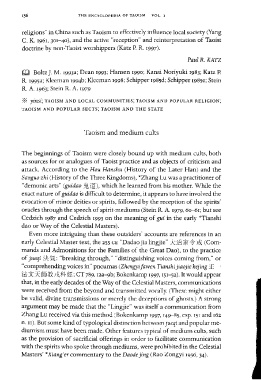Page 196 - The Encyclopedia of Taoism v1_A-L
P. 196
THE ENCYCLOPEDIA OF TAOISM VOL. I
religions" in China such as Taoism to effectively influence local society (Yang
C. K. 1961,301-40), and the active "reception" and reinterpretation of Taoist
doctrine by non-Taoist worshippers (Katz P. R. 1997).
PaulR. KATZ
W Boltz J. M. 1993a; Dean 1993; Hansen 1990; Kanai Noriyuki 1983; Katz P.
R. 1995a; Kleeman 1994b; Kleeman 1998; Schipper 1985d; Schipper 1985e; Stein
R. A. 1963; Stein R. A. 1979
* yinsi; TAOISM AND LOCAL COMMUNITIES; TAOISM AND POPULAR RELIGION;
TAOISM AND POPULAR SECTS; TAOISM AND THE STATE
Taoism and medium cults
The beginnings of Taoism were closely bound up with medium cults, both
as sources for or analogues of Taoist practice and as objects of criticism and
attack. According to the Hou Hanshu (History of the Later Han) and the
Sanguo zhi (History of the Three Kingdoms), *Zhang Lu was a practitioner of
"demonic arts" (guidao ~@:), which he learned from his mother. While the
exact nature of guidao is difficult to determine, it appears to have involved the
evocation of minor deities or spirits, followed by the reception of the spirits'
oracles through the speech of spirit-mediums (Stein R. A. 1979,60-61; but see
Cedzich 1987 and Cedzich 1993 on the meaning of gui in the early *Tianshi
dao or Way of the Celestial Masters).
Even more intriguing than these outsiders' accounts are references in an
early Celestial Master text, the 255 CE "Dadao jia lingjie" ::km~<.>-t:ltX: (Com-
mands and Admonitions for the Families of the Great Dao), to the practice
of jueqi 1.R:*t: "breaking through," "distinguishing voices coming from," or
"comprehending voices in" pneumas (Zhengyifawen Tianshijiaojie kejing lE .
it x* effi~JtX:f4 ~~; CT 789, 12a-9b; Bokenkamp 1997, 151-52). It would appear
that, in the early decades of the Way of the Celestial Masters, communications
were received from the beyond and transmitted vocally. (These might either
be valid, divine transmissions or merely the deceptions of ghosts.) A strong
argument may be made that the "Lingjie" was itself a communication from
Zhang Lu received via this method (Bokenkamp 1997, 149-85, esp. 151 and 162
n. H). But some kind of typological distinction between jueqi and popular me-
diumism must have been made. Other features typical of medium cults, such
as the provision of sacrificial offerings in order to facilitate communication
with the spirits who spoke through mediums, were prohibited in the Celestial
Masters' *Xiang'er commentary to the Daode jing (Rao Zongyi 1956, 34).

